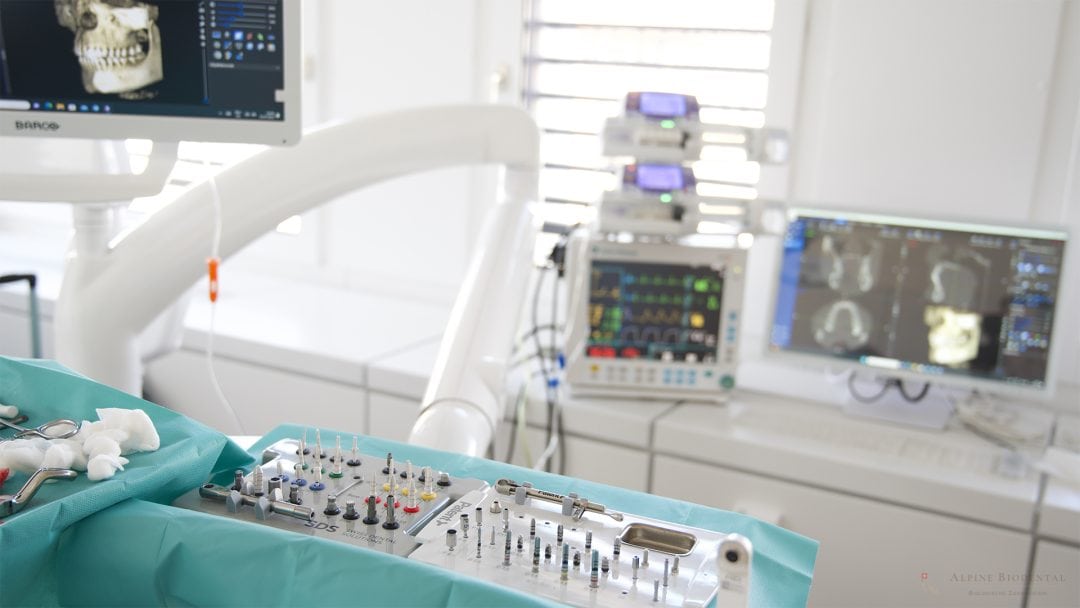General Anesthesia

General anesthesia at the dentist makes it possible to perform extensive dental treatments while the patient is in deep sleep. Patients who need a major dental restoration and especially people fear and anxiety can benefit from general anesthesia.
Before making a decision, it is important to learn and be informed about general anesthesia.
In this article, we would like to inform you about all aspects of this topic. This will help you find out if this method is right for you.
General anesthesia at the dentist - briefly explained
General anesthesia (or general anaesthesia) is an artificially induced deep sleep, which serves to completely eliminate the conscious awareness of dental surgery and pain.
The patient is not aware of the procedure at all and has no memory of it afterwards.
By administering various anesthetic drugs, the patient goes into a sleep-like state. They are administered intravenously, through an IV in the vein.
Other types of anesthesia
In addition to general anesthesia, there are other types of anesthesia used in dentistry that you should know about if you are considering whether or not to go under general anesthesia.
Local anesthesia
Local anesthesia is a classic local anesthetic used by dentists. Only the area to be treated is anesthetized. The patient is completely awake and responsive, but feels no pain in that specific area.
Nitrous oxide
A type of sedation in which oxygen and nitrous oxide (nitrogen-oxygen compound) are inhaled through a nasal mask. Nitrous oxide reduces the sensation of pain and has an anti-anxiety and sedative effect. Patients are in an alert and responsive state throughout. Laughing gas has one major disadvantage, which is why we do not use this form of anesthesia. It depletes the body of vitamin B12 and leads to vitamin B12 deficiency.
Twilight sleep
During twilight sleep (or conscious sedation), the patient receives strong painkillers and sedatives. They are administered either in pill form or intravenously, usually through a vein in the arm. The administered drugs begin to take effect after 10-15 seconds. The patient becomes calm, drowsy and has a temporary loss of memory. Unlike general anesthesia, independent breathing is maintained and ventilation may not be required.
When is general anesthesia used in dentistry
For various patients, it is of great advantage to have dental restorations carried out under general anesthesia. Usually patients already decide for themselves and know they want general anesthesia for their dental treatment/surgery.
Patients with dental fear
Patients who have had traumatic experiences at the dentist in the past tend to develop a fear visiting the dentist, so-called dentophobia. This fear can be so strong that even the thought of the dental chair, the drilling noise or the smell of the practice can trigger stress and panic. Dental fear is the most common reason for dental treatment under general anesthesia.
Strong gag reflex
A gag reflex can be so severe in some cases that all strategies are unsuccessful and dental treatment is not possible. General anesthesia is often the last resort for patients with severe gag reflex.
Major dental restorations
General anesthesia is recommended especially for major treatments/surgeries that can take up to several hours. These procedures include wisdom teeth extraction, dental implants, and long restorations in general.
Dr. Josephine Phillips
With a high level of experience, we can offer a complete restoration under general anesthesia without complications optimal results.

Steps of general anesthesia
The whole procedure of going under general anesthesia can be divided into different steps. These steps have been listen to give you a good understanding of a procedure with general anesthesia.
Informative talk
Before the planned procedure, a detailed informative talk and an examination with the dentist and the anesthesiologist will take place. Important health issues are clarified and, if necessary, various blood tests are done.
Sleep phase
In the treatment chair, the intravenous access is placed in the arm vein. With the help of a cream, the pain directly at the puncture site can be minimized so that the puncture is no longer felt.
The anesthetic medication is administered through the venous access and at the same time the patient breathes pure oxygen through an oxygen mask. Now it takes only a few seconds for the patient to fall into a deep sleep. A relaxation of the muscles occurs.Maintenance phase - deep sleep phase
Since the anesthetic medication also relaxes the respiratory muscles, independent breathing is no longer possible – the patient is artificially ventilated. Artificial respiration takes place via intubation through the nose into the throat and supplies the patient with oxygen. In addition, gaseous anesthetic drugs can be added to the supplied breathing air in order to control the anesthesia effectively and mildly at the same time.
The anesthesia team, which consists of at least 2 specialists, monitors all of the patient’s vital signs and can make quick adjustments. In addition to controlling pulse and blood pressure, care is taken to ensure that blood oxygen saturation is always at 98 – 100% and body temperature is at 37°. This allows for ideal blood clotting so that uncontrolled wound bleeding does not occur.
Since the patient is asleep, dental treatment can take place under ideal conditions and is completed more quickly and efficiently. Throughout the treatment, the dentist and anesthesiologist consult with each other to keep the duration of anesthesia and surgery as short as possible.
Waking up and recovery phase
Once the treatment is complete, the anesthesiologist administers a medication that ends the anesthesia and wakes up the patient. For the awakened patient, it feels like the dental procedure never took place.
The recovery time after general anesthesia is usually only a few days. After that, there are usually no after-effects.
The recovery time after general anesthesia depends primarily on the procedure performed.
General anesthesia risks
Many people are afraid of general anesthesia and especially of the possible risks. However, general anesthesia is a safe method and the risk is manageable.
However, there are always certain risks associated with all forms of anesthesia. These are due to the anesthetic medication used as well as the intubation for ventilation.
Risk of dying
The risk of dying from general anesthesia is approximately 1:250,000, which is less likely than the annual risk of dying in a car accident. Therefore, statistically, daily driving is more dangerous than general anesthesia.
Risk of embolism
An embolism is an occlusion of a blood vessel by a clot (thrombus). Since the patient is immobile during general anesthesia, a blood clot can form which can detach and block important vessels. This risk is also present during long air travel and bed rest.
To counteract this, the administration of heparin is necessary, especially during long procedures under general anesthesia.
Risk of confusion
In rare cases, postoperative confusion may occur after general anesthesia. In most cases, this is short-term and reversible.
After-effects and side-effects of general anesthesia
After-effects and side effects are relatively rare with general anesthesia. Overall, however, the likelihood of after-effects and side effects increases in older people and when the body is weakened. These usually last only a few hours to days and are completely reversible.
Nausea and vomiting
Nausea and vomiting occasionally occur after general anesthesia and subside within a few hours. It is a natural protective mechanism of the body, after the administration of medications/anesthetics.
Sore throat and hoarseness
Intubation, for artificial respiration, can irritate or easily injure the pharyngeal mucosa and larynx. As a result, a sore throat with difficulty swallowing and hoarseness may occur. This condition usually subsides completely after 2 days.
Tiredness and fatigue
A few days after general anesthesia, patients may feel tired and fatigued. These symptoms are similar to jet lag after long air travel and should subside quickly. Plenty of sleep and relaxation in the days following will bring rapid relief.
Feeling cold and muscle tremors
Immediately after waking up, a feeling of coldness is common and a patient may also have muscle tremors. This phenomenon is only short-term and is easily remedied by applying heat and keeping warm.
We use only anesthetic drugs with the best tolerability, which are quickly eliminated by the body. Patients can contact our anesthesiologists by phone – both before and after the surgery/treatment.
Cost of general anesthesia at the dentist
The cost of general anesthesia depends on the duration of the anesthesia. For longer treatments under general anesthesia, the anesthesia team must be present for longer and charge more accordingly.
The anesthesia team consists of at least one anesthesiologist and one nurse anesthetist. Since both team members must be paid, the cost of general anesthesia is relatively high. For large dental treatments lasting more than 5 hours, costs of approx. 3500 CHF can be expected.
Frequently asked Questions about general anesthesia at the dentist
Below you will find frequently asked questions about general anesthesia. The answers are short and precise. If you have any specific questions, please feel free to contact us.
In Switzerland, the patient has to cover the costs of general anesthesia. In some cases, dental insurance, IV or accident insurance cover a certain amount of the costs.
Depending on the patient’s health condition, various examinations are necessary. This is determined individually and discussed with the patient.
Very quickly. Patients fall asleep immediately after administration of the anesthetic medication. It usually takes no more than 30 seconds.
After the anesthesiologist administers a medication that ends general anesthesia, the patient slowly wakes up and is no longer asleep. However, fatigue is normal.
The anesthetics used are broken down very quickly by the body, so they are completely out of the system within a few hours.
You should not eat anything for at least 6 hours before the surgery.
You should not drink any fluids for at least 2 hours before the surgery.
General anesthesia for long dental treatments (over 5 hours) costs approximately CHF 3500.
During sedation there is usually no ventilation and breathing is maintained. In dentistry, sedation is an alternative only for short and simple procedures.
During general anesthesia, the patient is continuously monitored. All important vital parameters are constantly kept at ideal levels. This is very important, as any deviation from the ideal level can be a risk for the operation and the general anesthesia. For example, a body temperature that is too high or too low can impair blood clotting and wound healing. Due to the lack of muscle activity, hypothermia especially, is possible and should be avoided at all costs.
Sudden awakening during general anesthesia is very rare.
Allergies to the anesthetics are possible but quite rare. Based on the monitored vital signs, the anesthesiologist can quickly determine if there is an allergic reaction and make necessary adjustments.
After waking up, all vital signs will continue to be monitored.
The dentist will inform you about how the treatment went and you will be able to see the results. Depending on the dental treatment performed, you will have fixed temporaries or definitive ceramic restorations at this time. Due to the additional application of local anesthesia, you will not feel any pain after waking up.
Approximately one hour after the completion of the surgery, you will be able to leave the practice, accompanied.
Patients should not drive after general anesthesia. We recommend that you be picked up afterwards. We will be happy to arrange a ride home for you.
Both before and after the anesthesia, the dentist and anesthesiologist can be contacted by phone. This is important especially for patients with dental anxiety/fear. You can contact the practice at any time.
Further information
The information listed contains relevant topics for a better understanding.